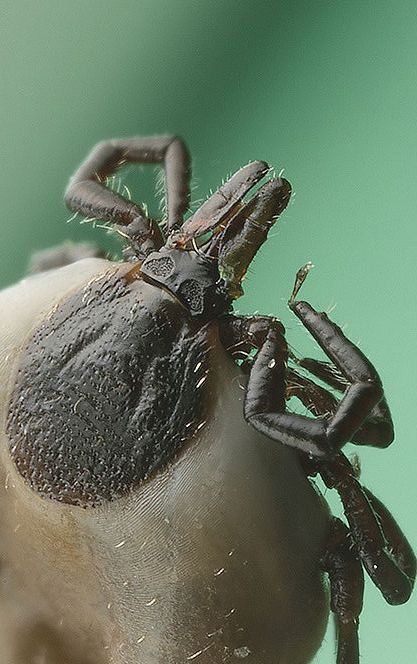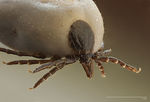Category:Hard Ticks - UK
The important tick species in the UK are all hard ticks as the environment does not suit the survival of soft ticks. They are distinguishable by differences in the morphology of the various important genera.
Ixodes spp.
Ixodes spp. can be identified by;
- Long palps
- Absent eyes
- Not ornate
- No festoons
- Anterior anal grooves
There are a number of Ixodes species present in the UK, however the most prevelant are I.ricinus, I.canisuga and I.trianguliceps.
I. ricinus
This hard tick is found throughout Europe and north Africa living in woodland, forests and bushes. Its life cycle can last between 1 and 6 years but normally takes 2 or 3 and involves three hosts. When feeding the female can grow up to 200 times her original size, feeding also causes paralysis in the host. The adults will target medium to large mammals such as sheep, cattle, dogs, deer, horses and humans whilst the larval and nymphal stages will attack smaller mammals, birds and reptiles. Once the adult female has fed once for a number of hours and mated on the host she will drop to the floor and lay her eggs in matted vegetation before dieing. I.ricinus is known to transmit Lyme disease (Borrelia burgdorferi) to cattle, horse and humans as well as Q fever (Coxiella burnetti). There a number of other infectious agents transmitted by ixodes species including Babesia divergens, B.bovis, B.ovis, Rickettsia conorii, Anaplasma marginale, Ehrlichia phagocytophila and Staphylococcus aureus.
I. canisuga
This is a host specific tick of dogs and lives in kennels in the UK and throughout Europe. Again it is a three host tick that can be active throughout the year. Females do not engorge greatly when feeding and although usually species specific the tick can spread disease to other animals such as badgers, minks, foxes and cats. In Russia the tick is known to spread Pasteurella pestis which causes plague.
I. trianguliceps
All stages of this tick attack small mammals such as mice, rats and voles but also accidentally found on man, horses, small birds and lizards. This tick is also a three host tick that lives in humid forested locations. It is known to transmit Babesia microti (human babesiosis) as well as Q fever, TBE, tuleraemia, Lyme disease and Louping ill.
I. hexagonus
This is known as the hedgehog tick however it will also affect dogs, ctas, ferrets and weasels. This is commonly seen in small animal practice.
Haemaphysalis spp.
Haemaphysalis spp. can be identified by:
- Wide palps
- Rectangular base of capitulum
- Eyes present on idiosoma
- Not ornate
- Festoons on posterior margin
- Posterior anal groove
The major species found in the UK, though rarely, is H.punctata, the red sheep tick. This is a three host tick that can complete its life cycle in a single year but in Wales takes between 2 - 3 years due to envirnmental conditions. H.punctata bites cause paralysis in sheep and cattle which the adults target as the third host, though they may also attach other medium to large mammals and humans. The larval and nymphal stages target small mammals, birds and lizards. As with many other ticks H.punctata transmits a number of diseases including tick born encephalitis (TBE), Q fever, tularaemia, Rickettsia slovaca, Theileria mutans, T.ovis, T.recondite, Babesia major, B.motasi, Anaplasma mesaeterum, Crimean Congo Haemorrhagic Fever, Borrelia burgdorferi (spanish lyme disease).
Dermacentor spp.
Rhipicephalus spp.
Rhipicephalus spp. can be identified by;
- Wide palps
- Hexagonal base of capitulum
- Eyes present on idiosoma
- Not ornate
- Festoons on posterior margin
- Posterior anal groove
There are 2 Rhipicepphalus species found in Europe; R.sanguineus,the brown dog tick is found in houses and kennels in the uK as outdoor conditions are not suitable. It is a three host tick and can complete its life cycle in 4 - 5 months, though this may take longer in colder conditions. This tick transmits Lyme disease (Borrelia burgdorferi), Babesia canis, B.gibson, Erlichia canis, E.vogeli, Salmonella enteritidis, Hepatozoon canis, Rickettsia conorii, Q fever, Rickettsia rickettsii (Rocky mountain spotted fever) to dogs. R.bursa, which infects horses is found in southern europe.
Pages in category "Hard Ticks - UK"
The following 4 pages are in this category, out of 4 total.

